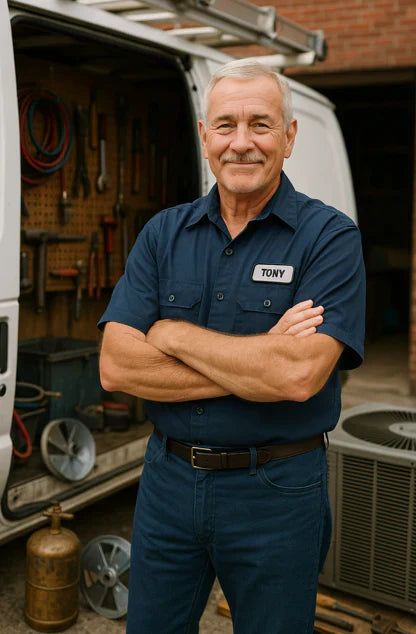🛠️ Hey Folks
👋Tony here. After 20+ years in the HVAC trenches, I’ve worked with every type of refrigerant, furnace model, and duct layout you can imagine. Lately, more and more homeowners and techs are switching to R‑32 air conditioners and furnaces—and for good reason: better efficiency, fewer emissions, and strong performance.
But with great cooling power comes new installation steps and troubleshooting quirks. In this blog, I’ll show you how to:
-
Properly install R‑32 PTACs, air conditioners, and gas furnaces
-
Handle A2L refrigerants like R‑32 safely and by code
-
Fix common issues like coil icing, sensor faults, and poor airflow
-
Avoid the classic mistakes that lead to callbacks
And yes—I'll drop in some real‑world advice to keep it safe, smart, and smooth along the way. 👨🔧🔥❄️
🔩 1. Site Prep and Safety First
Installing R‑32 units starts with the same rule as any good job: preparation is everything.
First up: location, airflow, and access. Keep at least 24" of clearance around outdoor units and don’t jam PTACs into tight wall openings without proper sleeve clearance. Check for overhead obstructions and airflow paths.
Here’s a good visual guide on airflow and installation clearance from This Old House that helps explain what can go wrong if the system doesn’t breathe right.
Also: R‑32 is a mildly flammable refrigerant (A2L), which means:
-
You must be EPA 608 certified
-
Tools need to be R‑32 compatible
-
No smoking, sparking tools, or open flames near charging zones
-
Always check for leaks before charging
-
Ventilate the work area thoroughly
- Safety is super important! Browse A2L Refrigerants 101: How to Work Safely with R-32 in Residential Systems to ensure you are working safely.
For more, check out this ASHRAE fact sheet on A2L refrigerants that explains safety zones, leak thresholds, and what kind of sensors are allowed.
🧱 2. Installing the System – PTACs, Splits, and Furnaces
Let’s break this down by system type. Most of what I install these days includes:
-
PTAC units for through‑the‑wall setups
-
Split systems with vertical furnaces and coils
-
5‑ton AC + furnace combos for full homes
PTAC Install Tips:
-
Ensure the wall sleeve slopes slightly outward (⅛") for drainage
-
Foam-seal the sleeve edges to prevent air leaks
-
Mount the chassis gently—don’t shove or jam
-
Plug into a dedicated 208/230V circuit with a clean ground
For more detail, Energy Star has a great guide on proper PTAC installation right here.
Split System Setup:
-
Lay a level condenser pad
-
Run properly insulated copper lines
-
Route electrical wiring in watertight conduit
-
Connect furnace plenum to coil cabinet with mastic and tape—don’t rely on just screws
-
Use a micron gauge to pull vacuum below 500 microns before charging
-
Add a float switch to the condensate line (a simple extra that saves disasters later)
Gas furnace? Remember to:
-
Pressure test gas lines (soap or electronic, never flames)
-
Install a sediment trap before the gas valve
-
Test CO levels at startup
💨 3. Wiring, Thermostats & Power-On
Here’s where systems either run like champs or go completely sideways.
-
Match wire gauge to circuit amperage
-
Bond ground wires properly
-
Confirm correct dip switch settings on the air handler or board
-
Test line and low-voltage circuits for shorts
-
Verify that your thermostat can handle dual-stage or multi-speed systems
One wiring mishap I see a lot is connecting the common wire (C) incorrectly, which can fry control boards. Take your time—especially if you're combining a new R‑32 AC with an older furnace.
If you want a breakdown of modern thermostat compatibility, this article from Build With Ferguson offers a good thermostat wiring guide that can save a lot of confusion.
🧪 4. Charging and Commissioning R‑32
After your vacuum hold passes, you're ready to charge. R‑32 has a lower GWP (675) and uses less refrigerant volume than R‑410A. This means you can’t guess based on old habits.
Weigh in your charge, check pressure charts, and never vent refrigerant to “adjust.” That’s illegal and unsafe.
Pro Tip: Always check the manufacturer’s subcooling and superheat specs. Too much refrigerant will cause high pressure, and too little will overheat the compressor.
🔍 5. Troubleshooting the Most Common R-32 Issues
Here’s a shortlist of the most common things I see in the field:
❄️ Coil Icing or Weak Cooling:
-
Dirty filter
-
Low refrigerant or leak
-
Faulty blower motor
-
Clogged TXV or metering device
⚠️ Error Codes (Blinking LEDs or Screens):
-
Consult the unit’s manual for code translation
-
Common ones: pressure faults, defrost cycle failure, open sensor circuit
🔥 Furnace Blowing Cold Air:
-
Flame sensor is dirty
-
Condensate switch tripped
-
Draft inducer isn’t starting
I love this guide from EIT on diagnosing HVAC failures — straight talk from the field with visuals.
🧯 6. Final Safety and Maintenance Notes
Don’t leave the job without:
-
Testing carbon monoxide levels near the furnace
-
Ensuring the R‑32 label is present and legible
-
Logging the charge, vacuum level, and test results in your service notes
-
Teaching the homeowner basic maintenance (filter changes, coil cleaning)
Also, set up a seasonal maintenance schedule with your client. You’d be amazed how much life a system gains from basic upkeep.
🧰 Outro
That’s a wrap, team! Whether you’re installing a PTAC in a tight hotel wall or wiring a full 5-ton system in someone’s basement, the rules stay the same: plan ahead, install smart, and always charge and test like it’s your name on the line—because it is 💪.
If you ever forget a step or just want to check your work, bookmark this page. And if you're looking for reliable, code-compliant R‑32 AC and furnace systems at unbeatable prices, head on over to The Furnace Outlet.
Stay safe, stay cool, and keep doing work that matters.
—Tony 👊







